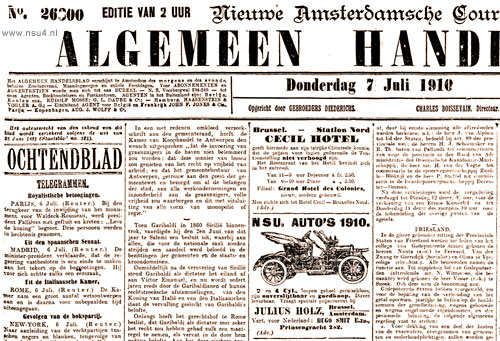Algemeen Handelsblad
The Algemeen Handelsblad ( General Handelsblatt ) was a national Dutch newspaper with editorial headquarters in Amsterdam.
History
The first edition of the Algemeen Handelsblad published on January 5, 1828th founder and first editor in chief was Jacob Willem van der Biesen. The newspaper first appeared twice a week and set to on a daily publication on 1 October 1830. Thus she became the first Dutch -language daily newspaper, even if they briefly again in 1831 with only three editions came out the week.
Already in the early years, the Algemeen Handelsblad positioned as a national newspaper, and sold 2,000 copies in 1835 by its large support only 400 in Amsterdam. Since the delivery at that time was still on cargo boats or stagecoaches, the newspaper could not be delivered on the release date outside of Amsterdam, which is why the newspaper was predated one day. During the French revolution of February 1848, the Algemeen Handelsblad served messaging even the help of pigeons. At this time, up to four issues published daily.
Also in the second half of the 19th century, the Algemeen Handelsblad took a leading role, it 1877 was the first newspaper that reprinted a color illustration. Since 1882, she appeared with two editions daily. 1885 sent the sheet than likely first newspaper in the Netherlands with Johan de Meester a correspondent abroad, in this case, to Paris. Previously, Dutch newspapers makes use only of the services of freelancers abroad. 1887 led the Algemeen Handelsblad as the first Dutch newspaper a daily editorial one.
Meanwhile, the newspaper had become a fixture in the media landscape and was one with a circulation of 9,000 copies in 1882, the largest daily newspapers in the Netherlands. Politically, it was close to the Liberals and was together with the Nieuwe Courant Rotterdamsche known to the rest over which had a similar meaning as the Algemeen Handelsblad all the time both newspapers, the figurehead of the liberal bourgeoisie in the Dutch media landscape. Until the Second World War, the circulation rose to about 50,000 copies.
After the Netherlands were in 1940 came under German occupation, the newspapers of the country still had a year of a degree of freedom, as long as the content is not contrary to the intentions was the occupying power. Subsequently, however, exacerbated the situation, and Willi Janke, head of the press department of the Reich Commissioner, decided together with Max Blokzijl, former Berlin correspondent for the newspaper and now Nazi press guard in the Department of Public Enlightenment and the Arts, at the prevailing anti-German Algemeen Handelsblad to set an example and let the state police come in the newspaper. A portion of the archives were confiscated and editor Daniel John arrested by Balluseck (1895-1976) together with one of the directors. Both were released after a month, however, an editor from the ranks of the Dutch Nazis NSB was appointed deputy editor and more new hires from the ranks of NSB brought into the leaf. This forced Nazification cost the sheet a majority of the subscribers.
After the war, the Algemeen Handelsblad could connect to the old meaning again, but looked increasingly faced with new competition from television and radio, which set the display market under pressure. Also increased the payroll, printing and paper costs. 1964 came the Algemeen Handelsblad, together with the Nieuwe Courant Rotterdamsche in the new joint editors Nederlandse Dagblad Unie ( NDU ) below. The latter newspaper was struggling with similar problems, what NDU decided against the initial resistance of the two editors to give up the independence of both these newspapers and in 1970 to merge the NRC Handelsblad. Despite initial circulation losses this newspaper developed following a successful title and had the mid-1990s reached a circulation value surpassing the predecessor of both newspapers put together by far.










